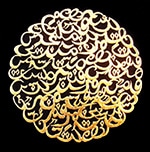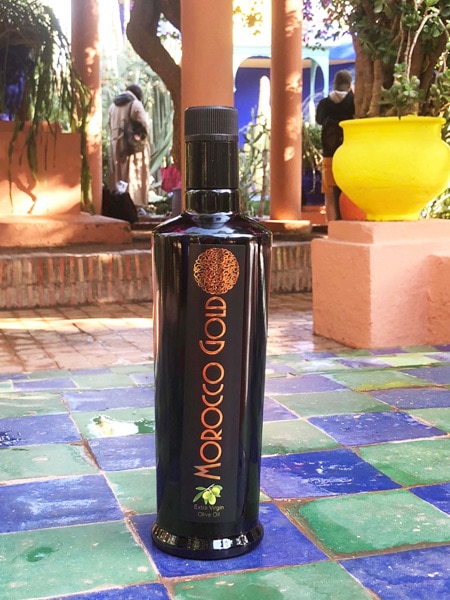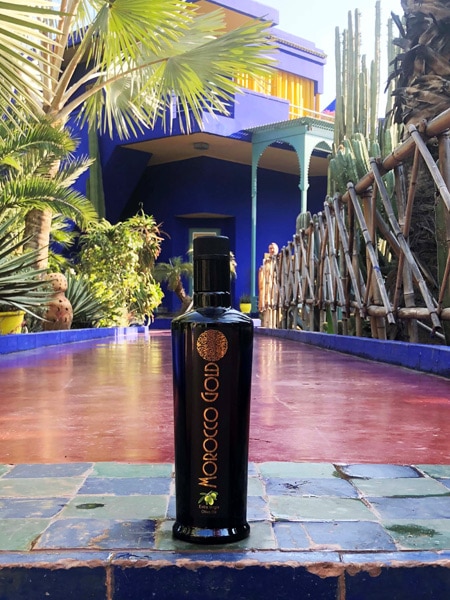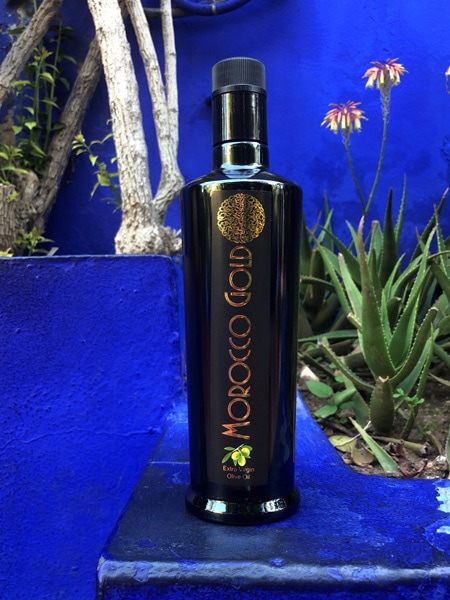Updated 31st May 2023
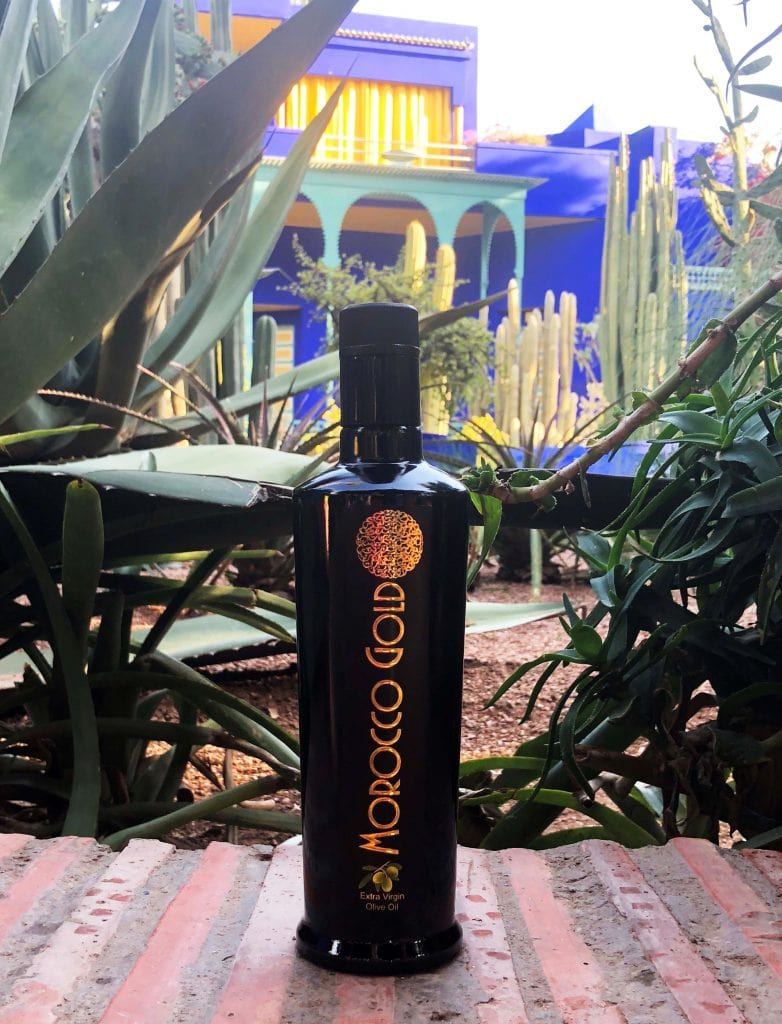
Contents:
- The Growing Popularity Of Moroccan Extra Virgin Olive Oil
- Morocco Gold Extra Virgin Olive Oil In Harmony With Majorelle Gardens
- Jacques Majorelle Artist
The Growing Popularity Of Moroccan Extra Virgin Olive Oil
Moroccan extra virgin olive oil is gaining popularity amongst health-conscious consumers. This exquisite Moroccan oil is known for its intense and delicate flavor, texture, and aroma. The oil is made from the first pressing of olives, which is why it is called “extra virgin.” The oil is richer in nutrients and antioxidants than the other types of olive oil, making it a healthy and nourishing addition to your diet. Moroccan extra-virgin olive oil is traditionally used for cooking, salad dressings, and dipping sauces, but it is also beneficial for hair and skin care. Its densely packed nutrients soothe, nourish, and moisturize skin and hair, leaving it silky-smooth and soft. Moroccan extra virgin olive oil truly embodies the essence of a healthy lifestyle.
And what better place to showcase this amazing extra virgin olive oil, Morocco Gold, than the exquisite Majorelle Gardens in Marrakech.
Morocco Gold Extra Virgin Olive Oil In Harmony With Majorelle Gardens
The Majorelle Gardens in Marrakech is one of the most visited sites in Morocco and is now a favourite with Instagrammers from all over the world. It took French painter Jacques Majorelle (1886-1962) forty years of passion and dedication to create this enchanting garden in the heart of the “Red City”.
Shady lanes between trees and exotic plants, refreshing streams and pools filled with water lilies and lotus flowers; the rustling of leaves and the chirping of numerous birds who come here to take refuge; a building with Moorish charm, with a hint of Art Deco, painted in astonishingly vibrant primary colours, glowing with an intense blue the artist perceived in the Atlas Mountains. The harmony of this luxuriant and vivid imagery exemplifies the power of ‘wellness’ and offers a calming retreat for visitors, near and yet so far from the bustling city, sheltered from time by high earthen walls.
It provides the perfect setting to celebrate the bounty of Morocco Gold extra virgin olive oil, it’s distinctive green fruity taste with hints of sweet almonds, fresh turf and herbs and the distinctive ‘pepperiness’ of a fine extra virgin olive oil. Also the timeless health enhancing properties of a high quality extra virgin olive oil like Morocco Gold that contributes towards inner health and well being.
Jacques Majorelle Artist
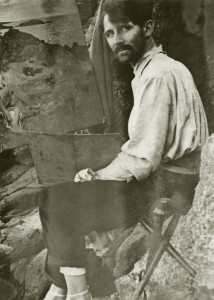
Jacques Majorelle was born in 1886 in Nancy, France, the son of the famous furniture designer, Louis Majorelle, who, with Emile Gallé, founded the Nancy School. He grew up in an ideal artistic universe, among draftsmen, cabinetmakers and marquetry inlayers from the workshops of his father, at a time when the Art Nouveau movement, largely inspired by shapes found in nature, was in full swing. Majorelle harboured a lifelong love for flora and fauna.
After three years of architectural studies, Majorelle decided to dedicate his life to his primary passion, painting, and attended the Ecole des Beaux-arts in Nancy and the Academy Julian in Paris. Travels through Brittany, Spain and Italy introduced him to the power of light. His trip to Egypt in 1910 led to his fascination with the Islamic world and its culture; he lived there for nearly four years.
In 1917, he arrived in Morocco. He quickly left behind the humid climate of Casablanca and discovered Marrakech, the oasis-city whose colours, light and “souks soaked with fertile and happy life” immediately bewitched him. For several years, the city was his base for numerous trips around Africa, before he moved there for good, with his wife, Andrée Longueville, whom he married in 1919.
In 1923, Jacques Majorelle bought a four acre land plot, situated on the border of a palm grove in Marrakech. The spot was planted partly with poplars, revealing the presence of water and inspired the artist with a name for his new property, Bou Saf Saf.
Before expanding his domain by buying adjoining parcels of land, until it reached nearly ten acres, he constructed a house in a sober Moorish style as well as workshops housed in another Berber-style building with a high adobe tower, the Borj. Alongside painting, he threw himself into the decorative arts, producing artisanal pieces, fine leather goods, carpentry and wooden painted furniture; the ceiling of a restaurant of the Mamounia Hotel, decorated with motifs inspired by Berber art, is by Majorelle. He also designed posters advertising Morocco as a tourist destination.
In 1931, he commissioned the architect, Paul Sinoir, to design a Cubist villa for him, constructed near his first house. His workshop, where he would paint his large decorations, was located on the ground floor, and he established a studio on the first floor where he spent much of his time. Balconies and an Arab-inspired pergola were added to the construction in 1933.
Around his dwelling, Jacques Majorelle, a passionate amateur botanist, created a luxuriant garden which would become his most dazzling work. For almost forty years, he continued to enrich it with new varieties of plants from all five continents, fashioning a “cathedral of shapes and colours,” an “impressive garden.”
Jacques Majorelle used to say: “The painter has the modesty to regard this enclosure of floral verdure as his most beautiful work.” He referred to the garden as “ vast splendours whose harmony I have orchestrated… This garden is a momentous task, to which I give myself entirely. It will take my last years from me and I will fall, exhausted, under its branches, after having given it all my love.”
The fame of Jacques Majorelle’s garden grew, and even surpassed that of his paintings. The more the artist travelled, the more he enjoyed gardening; he began to bring plants from around the world and to communicate internationally with people who shared his passion for botany. He acquired hundreds of rare varieties of trees and plants: cacti, palm trees, bamboo, coconut palms, thujas, weeping willows, carob trees, jasmine, agaves, white water lilies, datura, cypress, bougainvilleas, and ferns. As in the composition of a painting, Majorelle arranged the species between light and shadow around a long central basin and along irregular, meandering walkways with curved, painted walls.
The colours that Jacques Majorelle began to use in 1937 transformed his garden into an even more fascinating masterpiece. He first painted the facade of his studio, then all of his property including gates, pergolas, pots and the various buildings in a scheme of bold and brilliant primary colors, one of which would later be known as “Majorelle blue”, an ultramarine, cobalt blue, “evoking Africa”. Strong, deep, intense, it accentuates the green of the leaves and makes them sing.
When the Jardin Majorelle opened to the public in 1947, its fame was already well-established. At the end of his life, after having been forced to subdivide it on several occasions, Jacques Majorelle had to sell what remained. The garden, abandoned, fell into disrepair.
Yves Saint Laurent and Pierre Bergé buy the Jardin Majorelle in 1980
Yves Saint Laurent and Pierre Bergé discovered the Jardin Majorelle in 1966, during their first stay in Marrakech.
“We quickly became very familiar with this garden and went there every day. It was open to the public yet almost empty. We were seduced by this oasis where colours used by Matisse were mixed with those of nature. And when we heard that the garden was to be sold and replaced by a hotel, we did everything we could to stop that project from happening. This is how we eventually became owners of the garden and of the villa. And we have brought life back to the garden through the years.”
Pierre Bergé Yves Saint Laurent, “Une passion marocaine”

Yves Saint Laurent and Pierre Bergé bought the Jardin Majorelle in 1980 and saved it from falling victim to a real estate project and becoming a hotel complex. The new owners decided to live in the Villa Bou Saf Saf, which they renamed Villa Oasis, and undertook the restoration of the garden in order to “make the Jardin Majorelle become the most beautiful garden – by respecting the vision of Jacques Majorelle.”
Automatic irrigation systems were installed, adjusting the distribution of water according to hours during the day and to the specific needs of each plant. New plant species have been added since 1999, increasing the total number from 135 to 300. A team of 20 gardeners once again began working to maintain the garden, its ponds and fountains.
The painter’s studio has been transformed into a museum open to the public, dedicated to Berber culture, housing the personal Berber collection of Yves Saint Laurent and Pierre Bergé. Yves Saint Laurent would say he was able to find an unlimited source of inspiration in the Jardin Majorelle, and that he dreamt many times about its unique colours.
Other Sightings of Morocco Gold include the Beni Mellal Festival and the Punjabi Film Awards.
